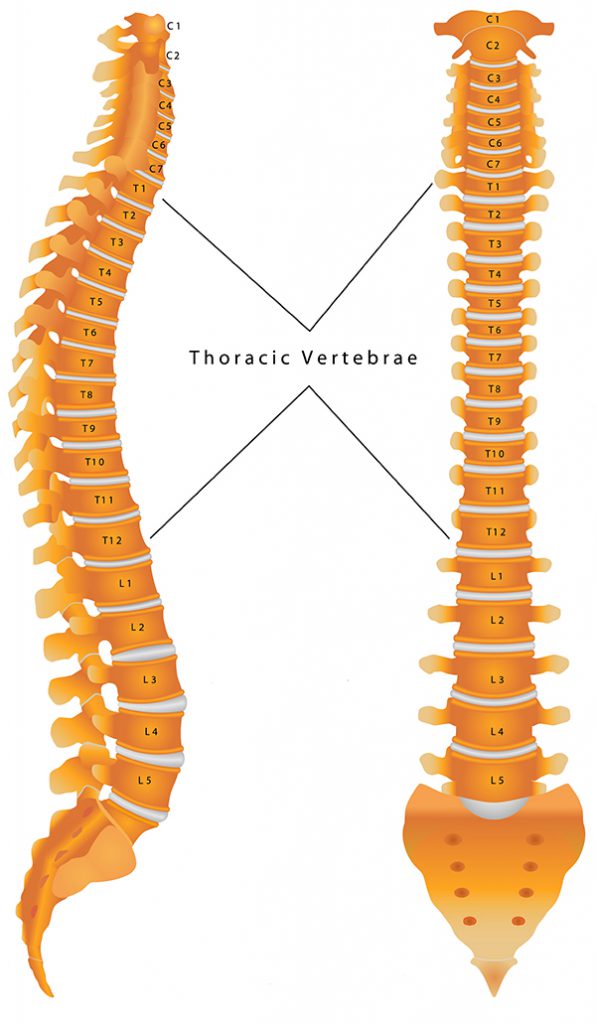Thoracic Spine
The Thoracic Spine
What is the thoracic spine?
The thoracic spine is located in the upper to the middle area of the back. It connects with the cervical vertebrae, extending down to approximately five inches below the bottom of the shoulder blades in an adult, where it then connects to the vertebrae of the lower spine.
The thoracic spine consists up of twelve vertebrae, and one of its main functions is to give the body stability. The cervical (upper) and the lumbar (lower) spine help the body to maintain its flexibility, but the stability of the thoracic spine plays a major role in holding the body in an upright position and protecting the heart and lungs.

When we consider what is thoracic spine structural elements we notice that many things about this part of the spine make it different from the other sections. In fact, the ribs connect to this portion of the spine. One rib firmly connects on either side of each of the thoracic vertebrae, in this way the rib cage structure and formation allows it to protect other vital organs such as the heart and lungs. The first ten ribs curve to the front of the body, attaching to the sternum. The next two ribs protect the kidneys in the back portion of the body and don’t attach to the front of the body.
The discs between the vertebrae of the thoracic spine work like shock absorbers. They have round shape but are not as thick as those in the other spinal sections. Nevertheless, herniated discs are less common in this area because fewer movement occurs here, and less wear and tear damage occurs.
The spinal canal is the hollow, protective tunnel, through which the spinal cord passes. It is narrower in the thoracic spine than it is in the lumbar or cervical spine. This means the spinal cord is more likely to be injured if one or more of the thoracic vertebrae are damaged or impaired.
There are two major muscles that affect the thoracic spine theses include:
-
- Spinalis. The Spinalis is a long muscle that is responsible for posture and spinal movement. The muscle has various ligaments attached to to the thoracic vertebrae.
- Longissimus. The Longissimus starts from the middle of the spine and is present on both sides of the spinalis. The longissimus is also a very long muscle of the spine.
What is thoracic spine pain and what are the issues that can occur with this section of the spine?
The thoracic spine is quite complex and contains bones, nerves, connective tissue, muscles, joints and spinal segments. It is solid and fairly stable, but while a pain in the thoracic spine is not as likely as in other parts of the spine, pain can is not entirely exempt from this region of the spine. Often when severe pain and is experienced in the thoracic region of the spine, it may be related underlying medical or health issues.
-
- Muscle pain: This can be caused by improper posture or irritation of the shoulder or large muscles of the back. It is sometimes called myofascial pain.
-
- Joint Dysfunction: This can be caused by a problem where the spine attaches to the ribs.
-
- Herniated discs: Herniated discs and degenerative disc disease do not happen so frequently in the middle section of the spine, but they can be a reason for pain in the mid-section of the spine.
-
- Arthritis: Arthritic conditions and associated inflammation can cause pressure on a nerve in the thoracic spine. The tissue in the joints can wear thin or bone spurs can form due to arthritis and cause enlargement of the joints.
-
- Fractures: Fractures due to bone thinning or osteoporosis sometimes occur in the thoracic spine.
- Kyphosis or Scoliosis: These are abnormal curvatures of the spine which can sometimes cause pain.
What is thoracic spine diagnosis?
There are several diagnosis procedures to help establish what the cause of the pain is and how to go forward with treatment. The patient's gait posture will be carefully observed as well as any abnormalities related.Inspection and examination of the spine will include:- - Disorders that may be localized within the thoracic region
- - The doctor will check for surgical scars and swelling
- - Assesment for deformities such as scoliosis, loss of lumbar lordosis or hyperlordosis as well as deformities such as kyphosis
- - Palpation examination for tenderness over the bones
- - The abdomen of the patent will also undergo examination
- - A rectal examination may be needed to look for signs of "Cauda Equina Syndrome". This could include bowel and bladder dysfunction, lower limb and motor abnormality as well as pain in the patient's legs.
- - The movement will be examined such as shoulders, spine, and hips
Other examinations will include:- - A neurovascular examination
- - Psychosocial factors
- - Neck examination and inspection
- - Cervical movement
Treatment of pain and symptoms causing discomfort in the thoracic spine
When considering what is thoracic spine pain is about, the treatment that follows is very important after the diagnosis. Seeking treatment for early signs of thoracic pain is best in order to prevent further injury. In most cases patients thoracic pain will resolve on its own, but in other cases depending on the diagnosis, the patient may need treatment and sometimes surgery.- - Facet joint pathology - may require imaging-guided intra-articular injection.
- - Percutaneous thoracic intervertebral disc nuceoplasty - is surgery done to relieve herniated disc as well as the pain associated.
You may also be interested in Thoracic Spine Fractures - causes, symptoms and treatment.






